The Application of 25G Optical Transceivers in 5G Network
The fifth-generation mobile communication (5G) technology is about to enter the commercialization process. Its new service features and higher metrics require new challenges for the bearer network architecture and various layers of technical solutions.
For 5G networks, 25/50/100Gb/s new high-speed optical modules will be introduced gradually in the pre-transmission, intermediate transmission and back-transmission access layers. The N×100/200/400Gb/s high-speed optical modules will be in the backhaul convergence and core layer. Introduced. Then 5G optical modules have different solutions in terms of transmission distance, modulation mode, operating temperature and packaging.
Typical requirements for optical modules in the 5G pre-transmission application scenario are as follows:
(1) Meet the industrial temperature range, reliability requirements High: Consider the AAU full outdoor application environment, the front light transmission module needs to meet the industrial temperature range of -40 ° C ~ +85 ° C, as well as dustproof, etc.
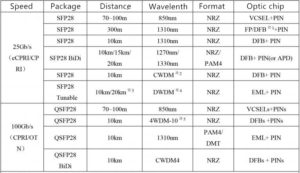
(2) Low cost: The total demand for 5G optical modules is expected to exceed 4G. In particular, the front transmission module may have tens of millions of orders. Low cost is one of the main demands of the industry for optical modules. The 5G backhaul covers the metro access layer, the aggregation layer and the core layer. The optical modules required by the existing optical network and the data center are not much different. The access layer will mainly adopt 25Gb/s and 50Gb/. For s, 100Gb/s gray light or color light modules, the aggregation layer and above will use DWDM color light modules with 100Gb/s, 200Gb/s and 400Gb/s.
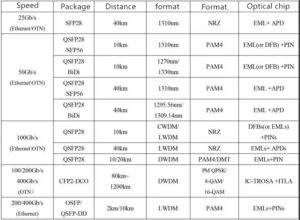
The prequel is the bearer of this part between AAU and DU. The distance is within 1~2km and the delay is high. It includes the following connection methods:
1. Fiber direct connection
Each fiber-optic point-to-point direct connection network is used between each AAU and the DU. In this way, the fiber resources occupy a lot, which is more suitable for areas with rich fiber resources. Generally, the 25Gb/s gray light module is adopted, which supports two types of bidirectional and single fiber bidirectional, mainly including two transmission distances of 300m and 10km.

2. Passive WDM
Install the color light module on the AAU and DU, complete the WDM function through the passive device, and provide multiple AAU to DU connections by using one or one optical fiber.
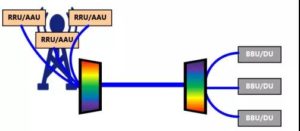
3. Active WDM/OTN
The corresponding WDM/OTN devices are configured in the AAU site and the DU equipment room, and multiple preamble signals share optical fiber resources through WDM technology.
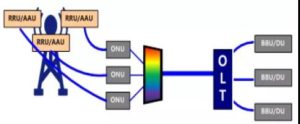
The 5G backhaul covers the metro access layer, aggregation layer and core layer. The optical modules required by the existing optical network and the data center are not much different. The access layer will mainly adopt 25Gb/s and 50Gb/. s, 100Gb/s rate gray light or color light module, aggregation layer and above will use more 100Wb / s, 200Gb / s, 400Gb / s rate DWDM color light module.
1. Packet enhanced OTN+IPRAN
The packet-enhanced OTN device with the route forwarding function is used to construct the intermediate transmission network, and the backhaul part continues to use the existing IPRAN (IF Radio Access Network) architecture. The BGP protocol is used for routing between the OTN and the IPRAN. Forward. In order to meet the load requirements of 5G bearers for large capacity and network slicing, IPRAN needs to introduce high-speed interface technologies such as 25GE, 50GE, and 100GE, and consider adopting new interface technologies such as FlexE (Flexible Ethernet) to achieve physical isolation and provide better. The quality of the bearer is guaranteed.
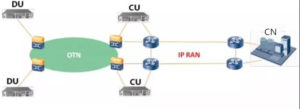
2. End-to-end packet enhanced OTN
Both the intermediate transmission and the backhaul network use the packet enhanced OTN equipment for networking.Compared with the packet enhanced OTN+IPRAN scheme, this scheme can avoid the problem of interworking and inter-professional coordination between packet enhanced OTN and IPRAN, so as to better utilize the powerful networking capabilities of packet enhanced OTN.
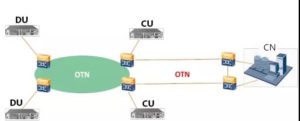
Current development level of 5G optical module industry
Optical module manufacturers at home and abroad actively carry out research and development of 5G optical modules around 5G applications. The current productization capabilities are shown in the following table.
In the 5G pre-transmission 25Gb/s optical module, the wavelength tunable optical module is in the research stage, the BiDi optical module is in the sample stage, and other types of optical modules are mature. The predecessor 100Gb/s BiDi optical module has a small application scale, and the 200Gb/s BiDi optical module and the 100Gb/s 4WDM optical module have matured. The 50Gb/s PAM4 BiDi 40km optical module, 400Gb/s direct modulation and coherent optical modules are all in the research stage in 5G, and other types of optical modules are basically mature.
Low cost is the main appeal point of the industrial chain for 5G optical modules. Specification grading, industrial chain sharing, technological innovation, and localization replacement are the main means to achieve low cost.
